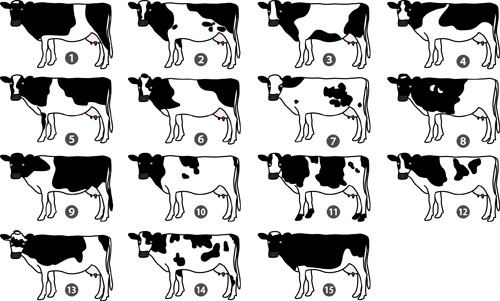The World Milk Day was set on June 1 by the United Nations’ Food and Agriculture Organization to draw attention to the benefits of drinking milk and to the whole dairy industry. Let’s make this day an opportunity to learn about milk cows!
Cow Quiz 1: How are black and white spotted markings of Holstein cattle laid out?
Dr. Popoloo: The best-known dairy cattle breed in the world is Holstein with distinctive black and white color patterns. Did you know that there are rules to how the patterns are laid out on a cow’s body?
Popolee: Don’t the patterns just pop up randomly?
Dr. Popoloo: No, you can’t classify cows as pure Holsteins just because they are black and white. Can you identify which of the cows in the illustrations are pure Holsteins?

Answer: All the cows except 3, 9 and 14 are Holsteins. There are six parts in a pure Holstein’s body which should be white; four feet, belly and a tip of its tail.
<Why milk is white, not green>
Poppo: I have a problem.
Dr. Popoloo: What’s wrong?
Poppo: Cows eat green grass, don’t they? Then why does milk turn white?
Dr. Popoloo: To tell you the truth, there are many reasons to it.
Popolee: I’ve heard that cows have as many as four stomachs. Is that the reason?
Dr. Popoloo: Oh, you sure know well. Cattle and deer are ruminants which bring back food into their mouth from their first stomach to chew again and digest fiber in the end. Did you know that most of other mammals can’t digest fiber?
Popolee: Really?
Dr. Popoloo: Out of the four compartments of the stomach, the first compartment contains special bacteria which break down fiber. In the second compartment, grass eaten by a cow is softened to make it easier for bacteria to digest and is brought back to the cow’s mouth. Then the grass is chewed again and re-swallowed, squashed in the third compartment to strain excessive water, and finally digested in the fourth compartment of the stomach.
Poppo: I see. Then, what about the color of milk?
Dr. Popoloo: Oh, I nearly forgot. Pasture grass is green when it’s fresh, but it’s not green when it is made into hay or silage, something like a fermented grass pickles. Besides, in order to increase the amount of milk, cows are also fed corn and soybean meal, so it’s not really correct to simply think that milk is made from green grass. The reason why milk is white is …
Poppo: Because cows are fed their mother cows’ white milk when they were babies!
Dr. Popoloo: Sorry, wrong answer. Actually, milk is made from red blood.
Popolee: Holy cow!
Dr. Popoloo: Blood is made up of various components, but is colorless when red blood cells are removed. It’s transparent. A component called blood plasma is necessary to produce milk, and lactose and amino acids contained in the blood plasma make milk look white when it comes out of a cow’s breast. Now you understand how it works.
Cow Quiz 2: How much milk does a dairy cow produce in a year?
Poppo: Milk cows are lucky because they can produce milk all year long. I envy them.
Popolee: Why?
Poppo: They can have as much milk as they want, don’t they?
Dr. Popoloo: I think you’ve got the wrong idea. A cow produces milk for roughly a year after giving birth to a calf.
Poppo: Oh, they don’t produce milk unless they have a calf? I thought all cattle produces milk, even bulls.
Popolee: It’s out of question for bulls to produce milk, but I didn’t know that cows produce milk only after giving birth to a calf. And it’s over in a year?
Dr. Popoloo: Actually, a cow should be ready for calving 80 days after the birth of her previous calf. Each cow gives birth to one calf at a time for three or four times, so generally speaking, a cow can be milked for three or four years.
Poppo: Isn’t the milk given to the calves?
Dr. Popoloo: Calves are fed their mothers’ milk for five days after birth. Cow’s milk is not fit for human consumption until six days after the birth of a calf.
Popolee: How much milk does a cow produce for human consumption in a year?
Dr. Popoloo: Make a guess.
Answer: A cow produces roughly 8,000 kilograms of milk a year. As a result of selective breeding, some cows can even produce 50 to 60 kilograms of milk in a day, which amounts to as much as 20,000 kilograms a year at most. Japanese Black cows that are reared for their meat also produce milk, but only about 10 kilograms a day.
<Dairy cows are rarely let out to pasture>
Popolee: It’s a beautiful day. Let’s go out for sketching in a pasture.
Dr. Popoloo: That’s a good idea, but…
Poppo: What’s the matter?
Dr. Popoloo: It’s rather difficult to find cows grazing in a pasture.
Poppo: Why?
Dr. Popoloo: Pastures save farmers a lot of trouble by providing a healthy environment for cows, but since the number of cows owned by each farmer is increasing, it is becoming difficult for them to secure pastures which are large enough. Some say there are also other problems such as the decline in the amount and the quality of milk produced. Different farmers have different ways of thinking, you know.
Popolee: So where can we find cows?
Dr. Popoloo: Most are housed in barns. There are two types of housing; one is fixed housing in which cows are tied up with a rope, and the other is free-stall housing in which cows can wonder around freely in the barn. Fixed housing reduces the burden of feeding cows and keeping them in good health, but it is rather troublesome to handle machines for milking and collecting manure in a limited space. Farmers with a large number of cows tend to prefer free-stall housing.
Poppo: That means we seldom see cows peacefully munching grass on vast pastures. If that’s the case, I’ll go and look for such rare pastures right away.
*Illustrations by Kenjiro Kogure
*Special thanks to Ikuo Osaka, chief researcher at the dairy cattle group of Hokkaido Research Organization’s Konsen Agricultural Experiment Station.
(June 1, 2013)


